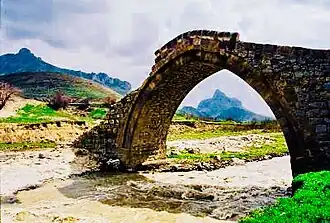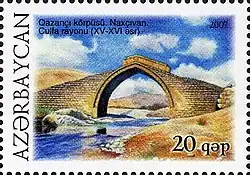Qazanchi Bridge
| Qazanchi Bridge | |
|---|---|
 | |
| Location | Qazançı, Nakhchivan,Julfa, Azerbaijan (city) |
| Coordinates | 39°14′02″N 45°42′11″E / 39.2338°N 45.7030°E |
| Area | Nakhchivan Autonomous Republic |
| Built | XVII century |
Qazanchi Bridge is a historical architectural monument built during the Safavid period, located in the territory of Qazanchi village, Julfa District, Azerbaijan.
The bridge was included in the list of architectural monuments of national importance by Decision No. 132 of the Cabinet of Ministers of the Republic of Azerbaijan dated August 2, 2001, and by Decision No. 98 of the Cabinet of Ministers of the Nakhchivan Autonomous Republic dated November 21, 2007.
About

Qazanchi Bridge was built over the Alinjachay River, to the south of Qazanchi village in the Julfa District of Azerbaijan.[1][2] Among locals, it is also known as the “Gozbel Bridge.”[2][3] Since there is no inscription on the monument, the exact date of its construction is unknown.[4] However, based on its construction technique and architectural-structural design, it is believed to date back to the early 17th century, during the reign of Shah Abbas I (1587–1629).[5][2]
This bridge once served the Silk Road, connecting caravan routes that extended eastward from Qazanchi village and joined the main road in the Ordubad region.[3][1] The bridge is 3.55 meters wide, 10.85 meters long, and 8.8 meters high.[3] It was built using roughly hewn rubble stones.[4]The arches' frames and archivolts are made of finely cut sandstone,[5][6] which visually distinguishes them from the uncut surfaces of the bridge walls, highlighting the structure’s architectural composition.[7]
After Azerbaijan regained its independence, Qazanchi Bridge was included in the list of immovable historical and cultural monuments of national importance by Decision No. 132 of the Cabinet of Ministers of the Republic of Azerbaijan, dated August 2, 2001.[8]
On November 1, 2007, the "Azermarka" company issued a set of five postage stamps dedicated to Azerbaijani bridges. One of the stamps, with a face value of 20 qapik and a circulation of 20,000 copies, was dedicated to Qazanchi Bridge.[9]
Later that same month, by Decision No. 98 of the Cabinet of Ministers of the Nakhchivan Autonomous Republic, dated November 21, 2007, Qazanchi Bridge was officially recognized as a monument of national architectural significance.[10]
In 2018, restoration work was carried out on the bridge.[11] This included reinforcing 120 meters of the surrounding riverbanks, replacing worn stones on the load-bearing parts, thoroughly cleaning the joints between the stones, and reapplying lime mortar to secure them.[5]
Source
References
- ^ a b Baxşəliyev, Quliyeva 2017, p. 186.
- ^ a b c Naxçıvan abidələri ensiklopediyası 2008, p. 121.
- ^ a b c İsayev 2012, p. 123.
- ^ a b Səfərli 2017, p. 124.
- ^ a b c Səfərli, Fəxrəddin (2018-12-06). "Tarixi-mədəni irsimizin yadigarı – Qazançı körpüsü |". nuhcixan.az (in Azerbaijani). Retrieved 2025-02-20.
- ^ Naxçıvan ensiklopediyası: I cild 2005, p. 330.
- ^ Baxşəliyev, Quliyeva 2017, p. 187.
- ^ "Azərbaycan Respublikası Nazirlər Kabinetinin 2001-ci il 2 avqust Tarixli 132 nömrəli qərarı ilə təsdiq edilmişdir" (PDF) (in Azerbaijani). mct.gov.az. 2001-08-02. Archived from the original (PDF) on 2021-07-07. Retrieved 2022-12-14.
- ^ ""The Bridges of Azerbaijan"". azermarka.az. 2007-11-01. Archived from the original on 2010-07-14. Retrieved 2025-02-20.
- ^ Naxçıvan Muxtar Respublikası ərazisindəki dünya, ölkə və yerli əhəmiyyətli daşınmaz tarix və mədəniyyət abidələri (in Azerbaijani). Naxçıvan: Qızıl dağ nəşriyyatı. 2009. p. 51.
- ^ "Qazançı körpüsü tarixi-memarlıq abidəsi bərpa olunub". turizm.nakhchivan.az (in Azerbaijani). 2018-02-11. Archived from the original on 2023-05-18. Retrieved 2025-02-20.
Literature
Ədəbiyyat
- Naxçıvan ensiklopediyası (in Azerbaijani). Vol. I. Naxçıvan: Elm nəşriyyatı. 2005. p. 360. ISBN 5806614689.
- The encyclopaedia of “Nakhchivan monuments” (in Azerbaijani). Naxçıvan: national Academy of sciences of Azerbaijan nakhchivan branch. 2008. p. 521.
- Baxşəliyev, Vəli; Quliyeva, Fizzə (2017). Naxçıvanın tarixi abidələri (PDF) (in Azerbaijani). Bakı: Nurlan nəşriyyatı. p. 212.
- İsayev, Elbrus (2012). Böyük İpək yolu və Naxçıvan (in Azerbaijani). Bakı: Elm və təhsil nəşriyyatı. p. 214.
{{cite book}}: CS1 maint: ref duplicates default (link) - Səfərli, Hacıfəxrəddin (2017). Naxçıvanın türk-islam mədəniyyət abidələri (in Azerbaijani). Naxçıvan: Əcəmi NPM. p. 216.
{{cite book}}: CS1 maint: ref duplicates default (link)